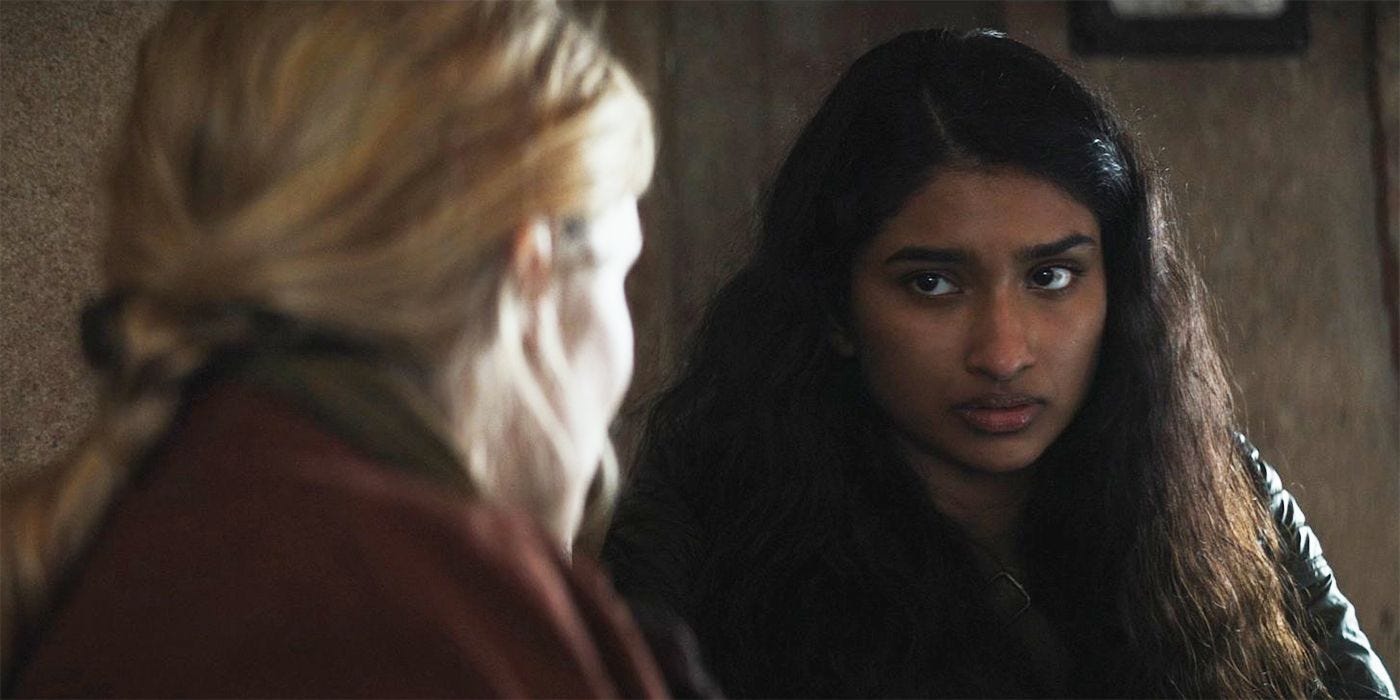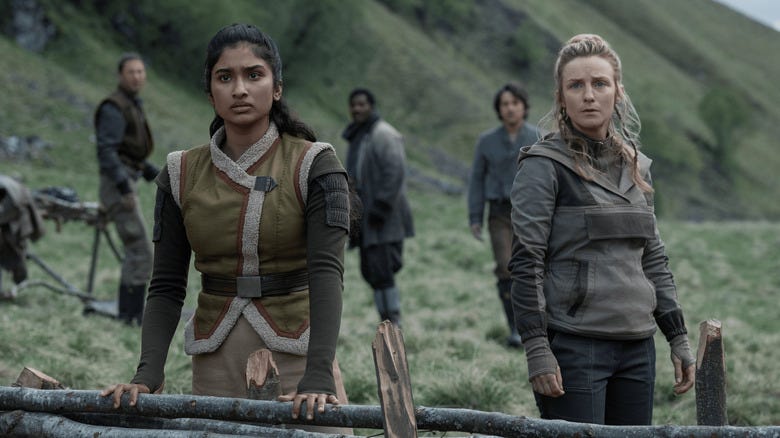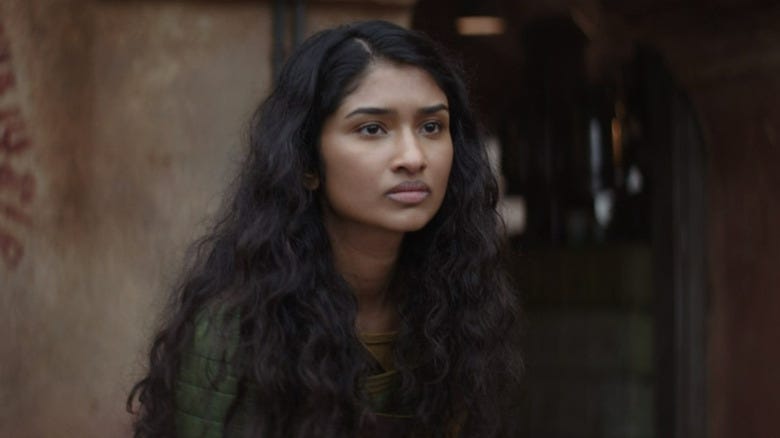if you Bury Your Gays in space, does anybody hear us scream
From the opening scene (space noir!) to the fact it runs straight through to Rogue One, I was hooked on Andor from the jump.
I love the whole show, deeply. In the kind of way I maybe haven’t loved any non-original-trilogy Star Wars thing since some of the Extended Universe books I read (and re-read) as a teen.
I’ve written an entire paean to its sound mix + edit.
The final episodes are some of the best TV of the year, and as a lover of and advocate for long-form storytelling I love that those episodes specifically work because they are television; the seasons-long buildup, character arcs texture of the world, complicated interplay of planetary and political parties with personal goals and growth and ambition, culminating in character decisions and plot points which have spent hours and years in the making to carry deep import.
Because I love Andor, I have the credentials, the right, even the obligation, to be mad about it, too.
major spoilers for Andor Season 2 follow
I’ve worked to be Positive On Main the last few years; we made one of our ethos at Shot Zero to talk about what we LOVE, why and how things work.
But some things are worth being mad about.
Burying Your Gays is one.
And Andor does it, then doubles down.
All quotes throughout cited from this interview unless otherwise noted.
The whole concept of saying “[if you] just treat it like it’s a normal thing and kill whoever you wanna kill, then that’s a problem all of a sudden.” is at best wilfully ignorant and at worst . . . real damn bad.
‘We didn’t consider’ is not actually a defence.
Let’s be clear, killing a queer character does not equate to burying a gay. My beef is not about the fact Cinta dies, nor even that she dies immediately after reconciling with her lover — or as my friend Jon put it when Vel and Cinta kissed: ‘aaah yes, horror movie logic!’
It’s that beat. for. beat. for. beat. for BEAT. it copies the two most famous lesbian deaths in TV: Buffy (which is shorthand for this trope in everything from doctoral thesis to casual bar convos) and The 100 (which sparked backlash, billboards, and an entire ‘stop burying your gays’ movement).
Queer women with Extended Fraught History finally reconcile after a long time / distance? Check.
Queer [very much offscreen] sex? Check.
Angry tertiary character man tangentially related to the story of one or both queer women does something stupid, which leads to ‘accidentally’ shooting the one of the women? Check, check, check.
That woman almost instantly dying in her lover’s arms? Check.
You could significantly change even one of those myriad of details, tweak a few of them, the story still works without egregiously, conspicuously, dirt flying everywhere, burying the gays.
Yet they didn’t.
That is certainly a choice.
Now, Gilroy notes the story is effective, and I agree. You can, of course, be effective and also bad, transparently manipulative, maudlin, etc.
Here, this story is effective in great part because the performances in this story and those surrounding it are superb before and after the event, and the intercutting with other events both makes it feel part of a larger tragedy. The actors sell it, while the episode structure and execution overall distracts somewhat from the more egregious trope writing, the way a magician waving their hand one place means you don’t see them slipping the card out of their shirtcuff.
Regarding those intercutting elements and related to the interview, I’m also wholly in agreement with showing how stupidity, accidents, incompetence, and ‘disobeying the orders of someone brought in because she knows exactly how to make this work,’ can all result in horror and tragedy.
All of the above actually makes me more frustrated; the sharp acting, interwoven arcs, and very cogent points about futility of war are blunted by of the cheap BYG beats around it.
When you say your approach to writing queer characters is “just treat it like it’s a normal thing” you don’t get a pass when that treatment shows itself devoid of contextual understanding. Our normal, queer peoples’ normal, has not been the same as everyone’s normal! Depicting our existence and our ‘normal thing’ inherently means handling some extra spiky issues; that’s part of the job.
Making queerness crystal clear (as you do with a kiss) only to immediately narratively punish it (with death, among other things) was once strictly codified, then turned harmful trope, and is somehow still happening. When the first explicit queer representation in this entire screen universe is followed by one of those characters being dying in the others’ arms, what does that say?
Depicting Vel and Cinta’s relationship in a galaxy which has been around almost fifty years and nine days of canonical Star Wars screen tales [that link’s tally is pre- Andor S2] before we got named queer characters so much as exchanging a kiss? That’s not treating it ‘like it’s normal’ and you do have to reckon with that, along with the rest of your canon events, whether you want to or not.
Writing queer characters the same as the straight ones doesn’t actually work if you treat everyone exactly the same, because contexts, background, and history are different. Writing them to the same effect can work, but that only comes through treating everyone with the same care and dignity and understanding of their history.
Which means understanding why it matters Cinta is queer within the particulars of this story and ending.
For a moment, imagine someone writing a story in 2025 where a dude breaks into a house, kills a woman and arranges the body in her refrigerator. Later the woman’s husband comes home, finds her, and the experience causes him to turn to a life of revenge. Then the writer says “how dare people be mad at me because I had the audacity to give my character real motivation to turn to a life of vigilanteism! I wrote a home invasion story which treated this woman like I would treat anyone who got in the way of a violent criminal. Of course, female viewers want to identify with this woman character, so they were upset at her death, and then it’s a ‘problem’ all of a sudden.”
History, a little knowledge of your art, or a modicum of curiosity about the people you’re depicting, will show there’s a juuuuust a bit more to it.
When someone builds a narrative about obsessively studying and leveraging history to write a specific TV show, taking public and well-deserved pride in the precision used to create shadow stories of the real world, and has a whole staff of writers to be precise about a smaller fictional universe and broader cinematic context, that should include attention to story history and context of the artistic medium, as well.
In other words, if you claim history deeply matters in the context of your show, you have to act as though queer history matters, too. Instead of declaring “the problem with it is that everybody’s going to identify with different people in the show. [. . .] So if you’re queer, you’re gonna climb in to this character.”
That quote / ‘explanation’ is an inaccurate and disingenuous assessment of the response to this story.
I couldn’t count on both hands the number of queer (or straight) characters I have seen die on screen in the last decade, who I identified with, and who made me feel all kinds of ways, but which did not make me Like This. In fact, I’ve discussed in depth several of those, including this one (spoilers for a Mike Flanagan show in that link; if you don’t know, don’t click), as well as different angles you can read when a character is coded instead of openly queer.
Why not? Because those characters didn’t die in a way which so closely copied a well-known queer trope that you could put the exact script into an SNL sketch, act and film it a different way, and have it be a parody of history.
The arc, method, and depiction of Cinta’s death not merely history repeating itself; they’re copying a television template which has been discussed (and discussed, and discussed, in industry panels as well as all over the internet) and cited as harmful.
They copy its elements so directly it feels like a college freshman running late on assignment gave ChatG%T the prompt “gay woman make love death how.”
‘Well that’s just TV, it’s not real history.’
First, by nature of our history, (including closeted existence, coded depiction, and historical revisionism) queer representation involves a lot more art (and sport) than most other specific people groups. Literature, film, and TV is a crucial aspect of not just documentation of our existence but representation within society and a push for acceptance, legal status, and more.
But, more relevantly to this particular point, ANDOR. IS. TV.
Respect the potential, history, and impact of the very thing you’re making (and treating seriously in other ways), or what are you even doing?
Who in any show I identify most deeply with, and why and how, is a buy-me-a-beer discussion. And, it’s true I’m emotionally invested in Cinta’s story, and upset by her death.
But that latter is not because my identification with a character via expression of sexuality leads me to believe that character is untouchable.
It’s because I’m invested in breaking the harmful narrative — recent as well as historical, fictional as well as real life — in which queer people are punished and killed as soon as they openly pursue love or sex.
Giving a queer character a plotline which doesn’t just echo the outlines but traces hyperspecifics of a trope used to kill similar characters for decades isn’t treating them as equal, and it’s not respecting your audience, either.
It’s just burying by another name.











